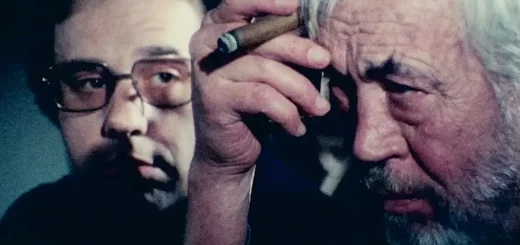Trial by Fire: There Has to Be a Better Way, by David Bax

Jack O’Connell spends most of Edward Zwick’s Trial by Fire wearing prison jumpsuits behind bars or glass. Those who saw him in David Mackenzie’s superior Starred Up from 2013 won’t be surprised to learn that his performance here is the most electric, authentic element of the movie. However, for his costar, Laura Dern, Trial by Fire is a very rare misstep. She doesn’t seem to wear naivete well but the real problem might have been on the page. Her divorced mom turned anti-death penalty activist is meant to be an audience surrogate. And this movie thinks its audience are morons.
In this real life tale, O’Connell portrays Cameron Todd Willingham, who was convicted of killing his three children by arson while their mother was at work in December of 1991 and was sentenced to death by the state of Texas. Dern plays Elizabeth Gilbert (not the author), whose volunteer work makes her, at first, a trepidatious visitor to Willingham at the prison, like a secular Sister Helen Prejean. Before she herself even quite realizes it, though, she becomes Willingham’s most fervent crusader, amassing a wall of evidence that he is innocent and that his original trial was botched.
Proof of the movie’s low opinion of you, the viewer, pops up almost immediately. The screenplay, by Geoffrey Fletcher (based on David Grann’s article in The New Yorker) shows us the investigations of the police and the prosecution first, stacking the deck so far in favor of Willingham’s guilt that the eventual turn is blatantly telegraphed. It’s like when the infomercial host assumes the wonder product being advertised must be wildly expensive. Later, as Willingham’s execution date draws near, one of the guards starts telling him a story about a famous “Hail Mary” football play. You’d have to be an idiot to think, “Now, where is he going with this?” But an idiot is exactly what Trial by Fire thinks you are.
Zwick and Fletcher’s dedication to their cause is noble; the death penalty is government-sanctioned murder and it shames all of us who live in states that practice it. Still, dedication doesn’t, on its own, make a movie engaging. Other, potentially interesting, elements are cast aside. The highly dysfunctional relationship between Willingham and his wife, Stacy (Emily Meade), is left to die on the vine. And only passing reference is made to the era’s fascinating, deeply damaging “satanic panic,” when detectives imagine they see a pentagram in the ashes of Willingham’s house. These rumors of ritualized violence committed by devil worshipers were somehow believed by millions at the time and offenses as slight as listening to heavy metal damned people like the West Memphis Three. Willingham may have been a victim of the hysteria, as well, but Zwick doesn’t care enough to explore it, decorating Willingham’s bedroom with posters for Dimmu Borgir and Kataklysm, bands that hadn’t even released music yet in 1991.
Rare notes of gracefulness eventually do pop up, though. Trial by Fire‘s most moving moments are when Willingham and Gilbert imagine themselves in the places inhabited by one another. These expressionistic projections find Dern in a prison cell or O’Connell in a suburban kitchen.
It’s almost shocking that Zwick doesn’t mar these simple, emotional moments by overselling them the way he does so much of the movie. A montage of far flung characters all listening to the same radio broadcast about Willingham’s impending execution obliterates credulity. Stacy, for example, doesn’t seem like the type to spend her afternoons listening to the news in her living room. For a movie based on a true story, most of Trial by Fire feels like bullshit.




























